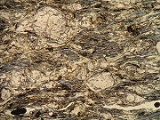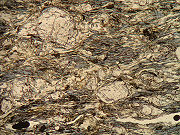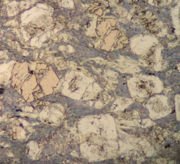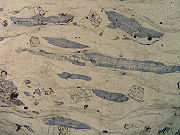
Blueschist
Encyclopedia

Rock (geology)
In geology, rock or stone is a naturally occurring solid aggregate of minerals and/or mineraloids.The Earth's outer solid layer, the lithosphere, is made of rock. In general rocks are of three types, namely, igneous, sedimentary, and metamorphic...
that forms by the metamorphism
Metamorphism
Metamorphism is the solid-state recrystallization of pre-existing rocks due to changes in physical and chemical conditions, primarily heat, pressure, and the introduction of chemically active fluids. Mineralogical, chemical and crystallographic changes can occur during this process...
of basalt
Basalt
Basalt is a common extrusive volcanic rock. It is usually grey to black and fine-grained due to rapid cooling of lava at the surface of a planet. It may be porphyritic containing larger crystals in a fine matrix, or vesicular, or frothy scoria. Unweathered basalt is black or grey...
and rocks with similar composition at high pressure
Pressure
Pressure is the force per unit area applied in a direction perpendicular to the surface of an object. Gauge pressure is the pressure relative to the local atmospheric or ambient pressure.- Definition :...
s and low temperature
Temperature
Temperature is a physical property of matter that quantitatively expresses the common notions of hot and cold. Objects of low temperature are cold, while various degrees of higher temperatures are referred to as warm or hot...
s, approximately corresponding to a depth of 15 to 30 kilometers and 200 to ~500 degrees Celsius.
The blue color of the rock comes from the presence of the mineral glaucophane
Glaucophane
Glaucophane is a mineral belonging to the amphibole group, chemical formula []Na2]Mg3Al2][2|Si8O22].-Name:It is named from its typical blue color . Glaucophane crystallizes in the monoclinic system....
.
Blueschists are typically found within orogenic belts
Orogeny
Orogeny refers to forces and events leading to a severe structural deformation of the Earth's crust due to the engagement of tectonic plates. Response to such engagement results in the formation of long tracts of highly deformed rock called orogens or orogenic belts...
as terrane
Terrane
A terrane in geology is short-hand term for a tectonostratigraphic terrane, which is a fragment of crustal material formed on, or broken off from, one tectonic plate and accreted or "sutured" to crust lying on another plate...
s of lithology in faulted contact with greenschist
Greenschist
Greenschist is a general field petrologic term applied to metamorphic or altered mafic volcanic rock. The term greenstone is sometimes used to refer to greenschist but can refer to other rock types too. The green is due to abundant green chlorite, actinolite and epidote minerals that dominate the...
or rarely eclogite
Eclogite
Eclogite is a mafic metamorphic rock. Eclogite is of special interest for at least two reasons. First, it forms at pressures greater than those typical of the crust of the Earth...
facies rocks.
Petrology
Blueschist, as a rock type, is defined by the presence of the minerals glaucophaneGlaucophane
Glaucophane is a mineral belonging to the amphibole group, chemical formula []Na2]Mg3Al2][2|Si8O22].-Name:It is named from its typical blue color . Glaucophane crystallizes in the monoclinic system....
+ ( lawsonite
Lawsonite
Lawsonite is a hydrous calcium aluminium sorosilicate mineral with formula CaAl2Si2O72·H2O. Lawsonite crystallizes in the orthorhombic system in prismatic, often tabular crystals. Crystal twinning is common. It forms transparent to translucent colorless, white, and bluish to pinkish grey glassy to...
or epidote
Epidote
Epidote is a calcium aluminium iron sorosilicate mineral, Ca2Al2O, crystallizing in the monoclinic system. Well-developed crystals are of frequent occurrence: they are commonly prismatic in habit, the direction of elongation being perpendicular to the single plane of symmetry. The faces are often...
) +/- jadeite
Jadeite
Jadeite is a pyroxene mineral with composition NaAlSi2O6. It is monoclinic. It has a Mohs hardness of about 6.5 to 7.0 depending on the composition. The mineral is dense, with a specific gravity of about 3.4. Jadeite forms solid solutions with other pyroxene endmembers such as augite and diopside ,...
+/- albite
Albite
Albite is a plagioclase feldspar mineral. It is the sodium endmember of the plagioclase solid solution series. As such it represents a plagioclase with less than 10% anorthite content. The pure albite endmember has the formula NaAlSi3O8. It is a tectosilicate. Its color is usually pure white, hence...
or chlorite
Chlorite group
The chlorites are a group of phyllosilicate minerals. Chlorites can be described by the following four endmembers based on their chemistry via substitution of the following four elements in the silicate lattice; Mg, Fe, Ni, and Mn....
+/- garnet
Garnet
The garnet group includes a group of minerals that have been used since the Bronze Age as gemstones and abrasives. The name "garnet" may come from either the Middle English word gernet meaning 'dark red', or the Latin granatus , possibly a reference to the Punica granatum , a plant with red seeds...
+/- muscovite in a rock of roughly basaltic composition.
Blueschist often has a lepidoblastic, nematoblastic or schist
Schist
The schists constitute a group of medium-grade metamorphic rocks, chiefly notable for the preponderance of lamellar minerals such as micas, chlorite, talc, hornblende, graphite, and others. Quartz often occurs in drawn-out grains to such an extent that a particular form called quartz schist is...
ose rock microstructure
Texture (crystalline)
In materials science, texture is the distribution of crystallographic orientations of a polycrystalline sample. A sample in which these orientations are fully random is said to have no texture. If the crystallographic orientations are not random, but have some preferred orientation, then the...
defined primarily by chlorite, phengitic white mica
Mica
The mica group of sheet silicate minerals includes several closely related materials having highly perfect basal cleavage. All are monoclinic, with a tendency towards pseudohexagonal crystals, and are similar in chemical composition...
, glaucophane, and other minerals with an elongate or platy shape.
Grain size is rarely coarse, as mineral growth is retarded by the swiftness of the rock's metamorphic trajectory and perhaps more importantly, the low temperatures of metamorphism and in many cases the anhydrous state of the basalts. However, coarse varieties do occur. Blueschists may appear blue, black, gray, or blue-green in outcrop. When lawsonite
Lawsonite
Lawsonite is a hydrous calcium aluminium sorosilicate mineral with formula CaAl2Si2O72·H2O. Lawsonite crystallizes in the orthorhombic system in prismatic, often tabular crystals. Crystal twinning is common. It forms transparent to translucent colorless, white, and bluish to pinkish grey glassy to...
occurs in blueschists, it appears as white tabular crystals.
Blueschist facies

Felsic
The word "felsic" is a term used in geology to refer to silicate minerals, magma, and rocks which are enriched in the lighter elements such as silicon, oxygen, aluminium, sodium, and potassium....
rocks and pelitic
Pelite
Pelite is old and currently not widely used field terminology for a clayey fine-grained clastic sediment or sedimentary rock, i.e. mud or mudstone. It is equivalent to the Latin-derived term lutite. More commonly, metamorphic geologists currently use pelite for a metamorphosed fine-grained...
sediments which are subjected to blueschist facies conditions will form different mineral assemblages than metamorphosed basalt.
Blueschist mineralogy varies by rock composition, but the classic equilibrium assemblages of blueschist facies are:
- Basalts: glaucophane + lawsonite and/or epidote + albite + titaniteTitaniteTitanite, or sphene , is a calcium titanium nesosilicate mineral, CaTiSiO5. Trace impurities of iron and aluminium are typically present...
+/- garnet +/- quartz jadeite + quartz - diagnostic of pressures ~> 10 kbar - Ultramafic rocks: serpentiniteSerpentiniteSerpentinite is a rock composed of one or more serpentine group minerals. Minerals in this group are formed by serpentinization, a hydration and metamorphic transformation of ultramafic rock from the Earth's mantle...
/lizardite +/- talcTalcTalc is a mineral composed of hydrated magnesium silicate with the chemical formula H2Mg34 or Mg3Si4O102. In loose form, it is the widely-used substance known as talcum powder. It occurs as foliated to fibrous masses, its crystals being so rare as to be almost unknown...
+/- zoisiteZoisiteZoisite is a calcium aluminium hydroxy sorosilicate belonging to the epidote group of minerals. Its chemical formula is Ca2Al3O... - PelitePelitePelite is old and currently not widely used field terminology for a clayey fine-grained clastic sediment or sedimentary rock, i.e. mud or mudstone. It is equivalent to the Latin-derived term lutite. More commonly, metamorphic geologists currently use pelite for a metamorphosed fine-grained...
s: Fe-Mg-carpholite +/- chloritoidChloritoidChloritoid is a silicate mineral of metamorphic origin. It is an iron magnesium manganese alumino-silicate hydroxide with formula: 2Al4Si2O104. It occurs as greenish grey to black platy micaceous crystals and foliated masses. Its Mohs hardness is 6.5, unusually high for a platy mineral, and it has...
+/- kyaniteKyaniteKyanite, whose name derives from the Greek word kuanos sometimes referred to as "kyanos", meaning deep blue, is a typically blue silicate mineral, commonly found in aluminium-rich metamorphic pegmatites and/or sedimentary rock. Kyanite in metamorphic rocks generally indicates pressures higher than...
+ zoisite +/- pargasitePargasitePargasite is a complex inosilicate mineral of the amphibole group with formula NaCa24AlO222.It was first described for an occurrence in Pargas, Finland in 1814 and named for the locality....
or phengitePhengitePhengite is a series name for dioctahedral micas of composition K224O10, similar to muscovite but with addition of magnesium. It is a non-IMA recognized mineral name representing the series between muscovite and celadonite....
+/- albite +/- quartz +/- talc +/- garnet - GraniteGraniteGranite is a common and widely occurring type of intrusive, felsic, igneous rock. Granite usually has a medium- to coarse-grained texture. Occasionally some individual crystals are larger than the groundmass, in which case the texture is known as porphyritic. A granitic rock with a porphyritic...
s: kyaniteKyaniteKyanite, whose name derives from the Greek word kuanos sometimes referred to as "kyanos", meaning deep blue, is a typically blue silicate mineral, commonly found in aluminium-rich metamorphic pegmatites and/or sedimentary rock. Kyanite in metamorphic rocks generally indicates pressures higher than...
+/- paragoniteParagoniteParagonite, also known as Natron-Glimmer, is a mineral, related to muscovite. Its empirical formula is NaAl2[2|AlSi3O10]. A wide solvus separates muscovite from paragonite, such that there is little solid solution along the vector Na+K+ and apparent micas of intermediate composition is most...
+/- chlorite +/- albite +/- quartz +/- pargasite or phengite - Calc-silicates: Various
- LimestoneLimestoneLimestone is a sedimentary rock composed largely of the minerals calcite and aragonite, which are different crystal forms of calcium carbonate . Many limestones are composed from skeletal fragments of marine organisms such as coral or foraminifera....
s and marbleMarbleMarble is a metamorphic rock composed of recrystallized carbonate minerals, most commonly calcite or dolomite.Geologists use the term "marble" to refer to metamorphosed limestone; however stonemasons use the term more broadly to encompass unmetamorphosed limestone.Marble is commonly used for...
: calciteCalciteCalcite is a carbonate mineral and the most stable polymorph of calcium carbonate . The other polymorphs are the minerals aragonite and vaterite. Aragonite will change to calcite at 380-470°C, and vaterite is even less stable.-Properties:...
transforms to aragoniteAragoniteAragonite is a carbonate mineral, one of the two common, naturally occurring, crystal forms of calcium carbonate, CaCO3...
at high pressure, but typically reverts to calcite when exhumed
Blueschist facies generally is considered to form under pressures of >0.6 GPa, equivalent to depth of burial in excess of 15-18 km, and at temperatures of between 200 to 500 °C. This is a 'low temperature, high pressure' prograde metamorphic path and is also known as the Franciscan facies series, after the west coast of the United States where these rocks are exposed. Well-exposed blueschists also occur in Greece, Turkey, Japan, New Zealand and New Caledonia.

Subduction
In geology, subduction is the process that takes place at convergent boundaries by which one tectonic plate moves under another tectonic plate, sinking into the Earth's mantle, as the plates converge. These 3D regions of mantle downwellings are known as "Subduction Zones"...
of blueschist facies oceanic crust
Oceanic crust
Oceanic crust is the part of Earth's lithosphere that surfaces in the ocean basins. Oceanic crust is primarily composed of mafic rocks, or sima, which is rich in iron and magnesium...
will produce eclogite
Eclogite
Eclogite is a mafic metamorphic rock. Eclogite is of special interest for at least two reasons. First, it forms at pressures greater than those typical of the crust of the Earth...
facies assemblages in metamorphosed basalt (garnet + omphacitic clinopyroxene). Rocks which have been subjected to blueschist conditions during a prograde trajectory will gain heat by conduction with hotter lower crustal rocks if they remain at the 15-18km depth. Blueschist which heats up to greater than 500 °C via this fashion will enter greenschist
Greenschist
Greenschist is a general field petrologic term applied to metamorphic or altered mafic volcanic rock. The term greenstone is sometimes used to refer to greenschist but can refer to other rock types too. The green is due to abundant green chlorite, actinolite and epidote minerals that dominate the...
or eclogite
Eclogite
Eclogite is a mafic metamorphic rock. Eclogite is of special interest for at least two reasons. First, it forms at pressures greater than those typical of the crust of the Earth...
facies temperature-pressure conditions, and the mineral assemblages will metamorphose to reflect the new facies conditions.
Thus in order for blueschist facies assemblages to be seen at the Earth's surface, the rock must be exhumed swiftly enough to prevent total thermal equilibration of the rocks which are under blueschist facies conditions with the typical geothermal gradient
Geothermal gradient
Geothermal gradient is the rate of increasing temperature with respect to increasing depth in the Earth's interior. Away from tectonic plate boundaries, it is 25–30°C per km of depth in most of the world. Strictly speaking, geo-thermal necessarily refers to the Earth but the concept may be applied...
.
Blueschists and other high-pressure subduction zone rocks are thought to be exhumed rapidly by flow and/or faulting in accretionary wedge
Accretionary wedge
An accretionary wedge or accretionary prism is formed from sediments that are accreted onto the non-subducting tectonic plate at a convergent plate boundary...
s or the upper parts of subducted crust, or may return to the Earth's surface in part owing to buoyancy if the metabasaltic rocks are associated with low-density continental crust (marble, metapelite, and other rocks of continental margins).
History and etymology
In 1962, Edgar Bailey of the U.S. Geological Survey introduced the concept of "blueschist" into the subject of metamorphic geologyGeology
Geology is the science comprising the study of solid Earth, the rocks of which it is composed, and the processes by which it evolves. Geology gives insight into the history of the Earth, as it provides the primary evidence for plate tectonics, the evolutionary history of life, and past climates...
. His carefully constructed definition established the pressure and temperature conditions which produce this type of metamorphism.
See also
- MetamorphismMetamorphismMetamorphism is the solid-state recrystallization of pre-existing rocks due to changes in physical and chemical conditions, primarily heat, pressure, and the introduction of chemically active fluids. Mineralogical, chemical and crystallographic changes can occur during this process...
- List of rock types
- List of minerals

